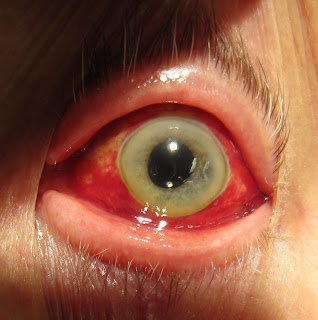
A 30 year old G2P1 woman at 28 weeks gestation is taken to the emergency department after a car accident. She was T-boned by a car which hit the passenger's side, but likely she was on the driver's side. On arrival, she says she "can't catch her breath."
The patient is afebrile. Heart rate is 100, blood pressure 100/60, respiratory rate 14, O2 sat 100% on room air. Extremity exam shows mild peripheral edema and a small water hammer pulse (rapid rise and brisk collapse). The JVP is easily visible. The apical impulse of the heart is at the fourth intercostal space, midclavicular line; it feels relatively hyperdynamic, though not sustained. Heart sounds are easily audible including a widely split S1, an S3, and a 2/4 systolic ejection murmur over the pulmonary and tricuspid areas. There is also a venous hum.
EKG shows a left axis deviation, left atrial enlargement, and an inverted T wave in lead III. The CXR shows mild cardiomegaly with increased pulmonary vascular markings. Hemoglobin is 11, hematocrit is 31, WBC 14,000, platelets 250. ABG shows a PaCO2 of 32, PaO2 of 107, and calculated HCO3 of 20. Creatinine is 0.4.
Challenge: The attending says, "I checked out the fetus and the fetus is fine, but tell me about the mother."
Image shown under Fair Use, from chronicle.pitt.edu.
 This is one of the more difficult EKGs I've found. This is seen in a young patient with no past medical history presenting with vertigo. Her electrolytes were normal. Cardiac enzymes were normal. Cardiac cath was normal.
This is one of the more difficult EKGs I've found. This is seen in a young patient with no past medical history presenting with vertigo. Her electrolytes were normal. Cardiac enzymes were normal. Cardiac cath was normal.











